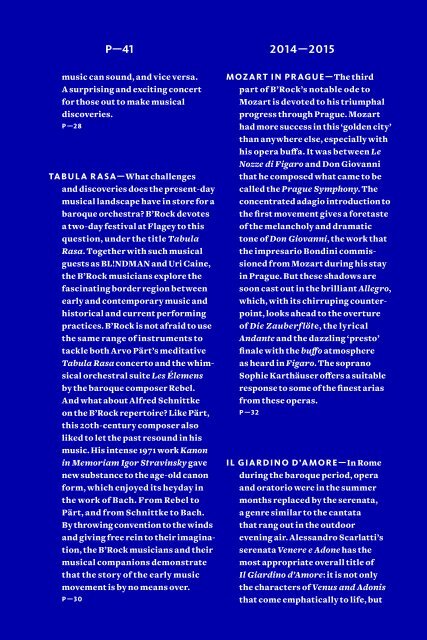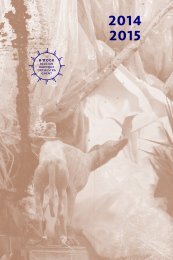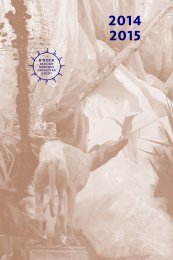You also want an ePaper? Increase the reach of your titles
YUMPU automatically turns print PDFs into web optimized ePapers that Google loves.
P—41<br />
2014—2015<br />
music can sound, and vice versa.<br />
A surprising and exciting concert<br />
for those out to make musical<br />
discoveries.<br />
P—28<br />
TABULA RASA—What challenges<br />
and discoveries does the present-day<br />
musical landscape have in store for a<br />
baroque orchestra? B’Rock devotes<br />
a two-day festival at Flagey to this<br />
question, under the title Tabula<br />
Rasa. Together with such musical<br />
guests as BL!NDMAN and Uri Caine,<br />
the B’Rock musicians explore the<br />
fascinating border region between<br />
early and contemporary music and<br />
historical and current performing<br />
practices. B’Rock is not afraid to use<br />
the same range of instruments to<br />
tackle both Arvo Pärt’s meditative<br />
Tabula Rasa concerto and the whimsical<br />
orchestral suite Les Élemens<br />
by the baroque composer Rebel.<br />
And what about Alfred Schnittke<br />
on the B’Rock repertoire? Like Pärt,<br />
this 20th-century composer also<br />
liked to let the past resound in his<br />
music. His intense 1971 work Kanon<br />
in Memoriam Igor Stravinsky gave<br />
new substance to the age-old canon<br />
form, which enjoyed its heyday in<br />
the work of Bach. From Rebel to<br />
Pärt, and from Schnittke to Bach.<br />
By throwing convention to the winds<br />
and giving free rein to their imagination,<br />
the B’Rock musicians and their<br />
musical companions demonstrate<br />
that the story of the early music<br />
movement is by no means over.<br />
P—30<br />
MOZART IN PRAGUE—The third<br />
part of B’Rock’s notable ode to<br />
Mozart is devoted to his triumphal<br />
progress through Prague. Mozart<br />
had more success in this ‘golden city’<br />
than anywhere else, especially with<br />
his opera buffa. It was between Le<br />
Nozze di Figaro and Don Giovanni<br />
that he composed what came to be<br />
called the Prague Symphony. The<br />
concentrated adagio introduction to<br />
the first movement gives a foretaste<br />
of the melancholy and dramatic<br />
tone of Don Giovanni, the work that<br />
the impresario Bondini commissioned<br />
from Mozart during his stay<br />
in Prague. But these shadows are<br />
soon cast out in the brilliant Allegro,<br />
which, with its chirruping counterpoint,<br />
looks ahead to the overture<br />
of Die Zauberflöte, the lyrical<br />
Andante and the dazzling ‘presto’<br />
finale with the buffo atmosphere<br />
as heard in Figaro. The soprano<br />
Sophie Karthäuser offers a suitable<br />
response to some of the finest arias<br />
from these operas.<br />
P—32<br />
IL GIARDINO D’AMORE—In Rome<br />
during the baroque period, opera<br />
and oratorio were in the summer<br />
months replaced by the serenata,<br />
a genre similar to the cantata<br />
that rang out in the outdoor<br />
evening air. Alessandro Scarlatti’s<br />
serenata Venere e Adone has the<br />
most appropriate overall title of<br />
Il Giardino d’Amore: it is not only<br />
the characters of Venus and Adonis<br />
that come emphatically to life, but





